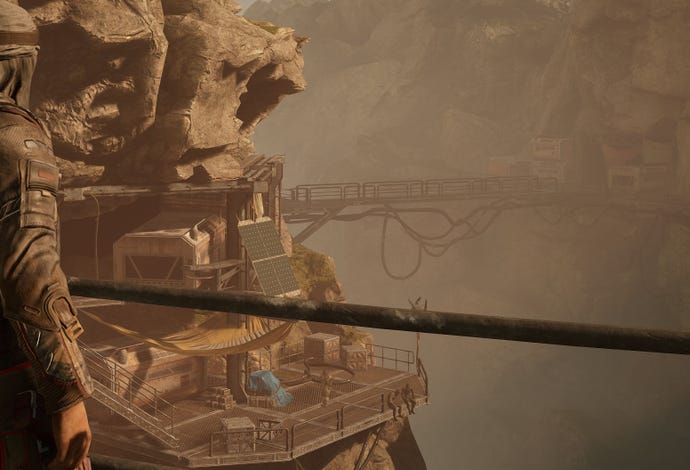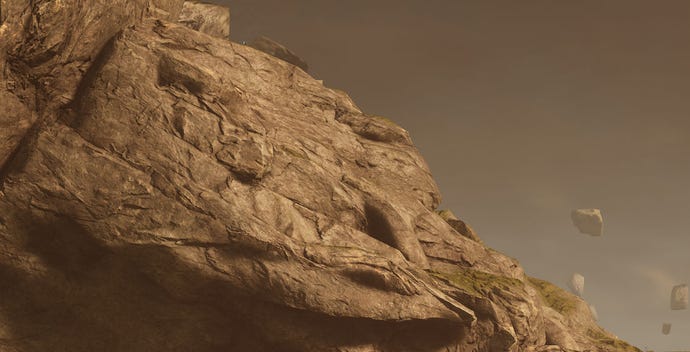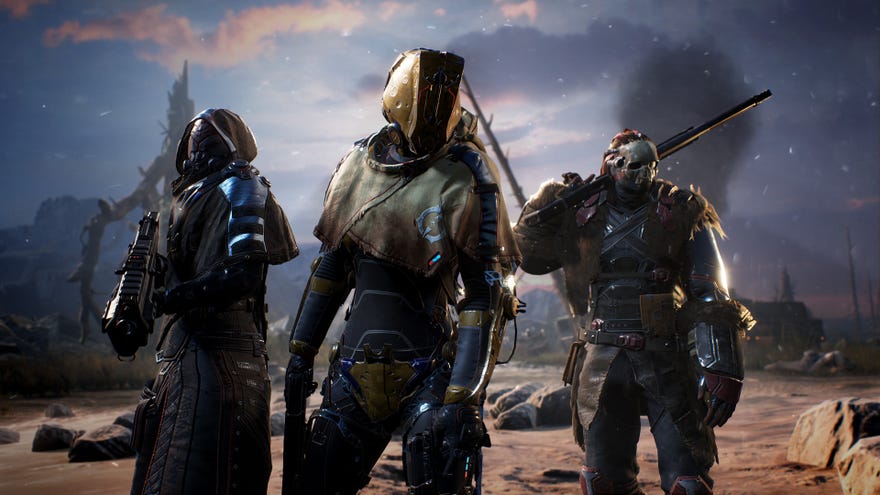Outriders' DLSS does a lot more than just improve performance
It also adds in extra details missing at native resolution
Outriders may have had a rocky couple of weeks since it launched at the start of April, but People Can Fly's new looter shooter does have a Destiny-like moreish-ness that makes it jolly good fun to play, especially when its headshots erupt in such spectacular fountains of gooey, red space chunks. It's entertaining stuff, as we said in our Outriders review, and from a performance point of view, it seems to be running relatively smoothly now that most of its early bugs and crossplay kinks have been ironed out.
However, to my eyes at least, some of the environments on old planet Enoch can sometimes look a little, well, plasticky. Outriders is a handsome-looking game, don't get me wrong, but stare at its glossy visual feasts for too long and their clean lines and smooth textures betray a distinct lack of nitty gritty detail. Even in its torn-up battlefields, there's very little roughage in the wilds of Outriders, as if every rock and mud track has been buffed and polished within an inch of its life, even on Ultra quality settings. But there is a way to bring back some of that missing detail to Outriders, and that's by enabling the game's Nvidia DLSS settings if you've got an RTX graphics card.
I know what you're thinking. Nvidia's DLSS tech is all about boosting frame rate performance, not adding more detail, right? And yes, its clever AI-based upscaling technology does indeed provide a welcome frame rate lift on all of Nvidia's current RTX cards. While it won't turn every RTX 20-series and 30-series card into a 4K 60fps powerhouse like it did in Death Stranding, it will let every RTX card play the game at 60fps on max settings at a resolution of 2560x1440, and those of you lucky enough to have bagged yourself an RTX 3060 Ti or above will be able to hit that coveted 4K 60fps mark as long as the game's DLSS setting is set to Performance mode. The RTX 3060 almost gets there on max settings, averaging in the low 50s in my performance tests, but you'll definitely have a much smoother ride playing at 1440p instead.
Performance mode is all well and good for keeping those frame rates nice and high, of course, but it's Outriders' DLSS Quality mode that actually makes the game look better, in my opinion. There are four DLSS options to pick from in total in Outriders' Display menu: Performance, Ultra Performance (if you're one of three people with an 8K display knocking around your home), Balanced and Quality. Performance and Ultra Performance, as discussed, prioritise frame rate over visual fidelity, Quality goes to town on ramping up the detail, while Balanced is meant to offer a nice mixture of the two.
Previously, I've found most DLSS games' Quality mode doesn't really add a huge amount to their overall presentation. In Death Stranding, for example, every mode looked much of a muchness to me. But Outriders' DLSS Quality mode showed a visual improvement when I started comparing screenshots to what the game looked like at its native resolution.
Let's look at an early scene from Rift Town, which sees your player character looking out over a rocky valley with all kinds of mad, floating rock physics magic taking place in the background. You can click to enlarge these screenshots in full over on the right, but I've cropped out the key details below. Playing at 4K resolution highlights these differences best, but I also saw a similar boost to the game's detail at both 1080p and 1440p as well. 4K screenshots are just a bit easier to look at here to illustrate what's going on.
Admittedly, at a quick glance, it doesn't look like much has really changed with DLSS Quality enabled, and in motion you'd probably be hard-pushed to notice the difference as well. But if you like to take your time in Outriders once you've finished clearing its rooms of goons and trying on all the different kind of space trousers they've left behind, then it's definitely worth switching on, as I think it not only makes textures look sharper and more defined, but it also adds in extra details you just don't get when playing without it.


In the screenshots above, the DLSS Quality image looks much clearer than its native counterpart, offering cleaner, more distinct edges and more detailed textures on the solar panel and floor grating. I can actually tell it's a solar panel, for starters, rather than some random grey rectangles. The same thing is true of the DLSS Performance and DLSS Balanced screenshots, too, with both offering significantly clearer visuals than 4K native.
You can see an improvement in the rock textures, too (below). At a native 4K resolution, the surface looks like it's been smeared in Vaseline, lending it that plasticky, artifical feel I mentioned above. It just doesn't look particularly real, which isn't really what you'd expect with every single setting dialled up as high as it can go.


Throw DLSS Quality in the mix, however, and the rocky surface immediately looks more realistic, like you'd properly scuff your knees sliding around up there rather than politely sliding along its rounded-off contours. DLSS Balanced and Performance offer a similarly rough and ready feel, too, although to my eyes DLSS Quality just pips them to the post on overall fidelity. Indeed, it's the kind of 4K Ultra quality you'd expect with everything on max, which is impressive stuff considering it's all been added in by Nvidia's AI-driven Tensor Cores rather than appearing in the game by default.
Now, I know that ultra gritty and grainy doesn't always make a game immediately more attractive. There was a Witcher 3 super duper texture mod that did the rounds last year that supposedly made the game look 500% more attractive because pigs, barrels and stone walls suddenly had loads more gristle and grime on them than before, but I'm still convinced that The Witcher 3 looks properly lovely even in its raw, native form without it. You may feel the same about Outriders, too, and that's fine. But if you've got an RTX card in your PC and, like me, can't quite shake the feeling that something's a bit off about the world of Enoch, then do yourself a favour and bung on DLSS. It not only helps the game run better, but it also makes it that bit lovelier to look at, too.










